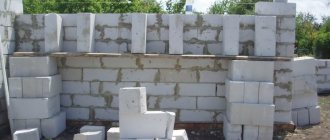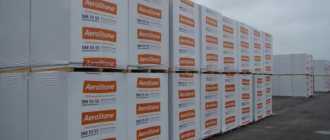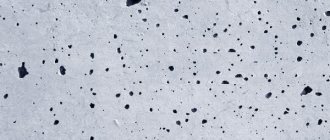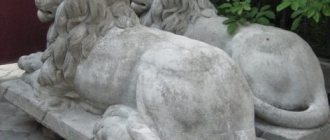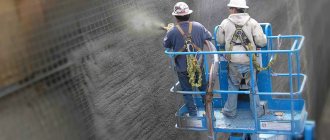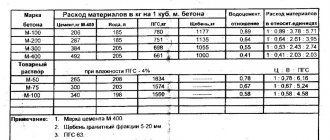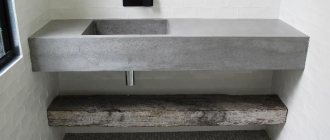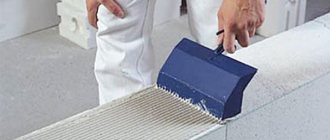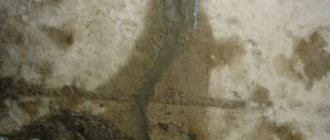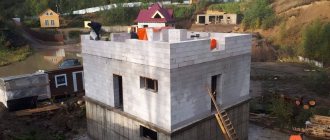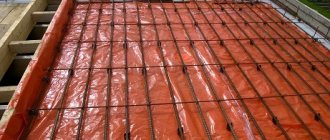Composition of the material, its production
Gypsum concrete is a material that is subject to the GOST 25192-2012 standard “Concrete. Classification and general technical requirements."
Component composition
The binding element in this concrete, unlike traditional materials, is not cement, but gypsum components (GOST 125-79 “Gypsum binders”).
Gypsum stone
Additionally, in the production of gypsum concrete, organic and mineral fillers are used to reduce costs, improve sound and heat insulation characteristics, and reduce fragility.
Organic fillers for gypsum concrete:
| Sawdust, shavings |
|
| Peat |
|
| Straw |
|
| Cellulose |
|
| Reed |
|
| Waste from flax and hemp processing |
|
As a result of the addition of organic fillers, the compressive strength of products is reduced, however, elasticity and thermal characteristics are improved.
Mineral fillers:
| Expanded clay |
|
| Pumice |
|
| Agloporite |
|
| Ash |
|
| Fuel slag without impurities |
|
| Sand |
|
| Crushed dolomite, limestone, granite |
|
| Tuff |
|
The addition of minerals makes it possible to increase the resistance of gypsum concrete to atmospheric conditions and its physical and mechanical properties.
On a note! In the manufacture of concrete with the addition of slag and sawdust, the following results were obtained: a product made from one part of gypsum, one part of slag and water has a density of 1340 kg/m3, a compressive strength of 80 kg/cm2, and a material made of one part of gypsum, one part sawdust and water has a density of 1000 kg/m3 and compressive strength in the range of 40-50 kg/cm2.
Important! In the production of this type of concrete, preference is given to aggregates that have a rough surface
Gypsum concrete produced using pumice has better thermal insulation characteristics due to the porosity of the material. When adding slag, it is necessary to sift out unburned particles. Pieces of slag less than 5 mm in size should not constitute more than 30% of the total volume of this filler.
Production of gypsum concrete materials
The production of gypsum concrete products is carried out using molding.
The manufacturing technology looks like this:
- Preparation of the solution.
The production of gypsum mass is carried out in two stages:
- First, the binder, fillers and additives are mixed.
- After this, the mixture is combined with water.
- The solution is thoroughly mixed in a mixing unit.
- The mixture is poured into collapsible molds, where a reinforcement cage is pre-installed (if reinforced products are produced). Filling is carried out in stages: after filling the mold 15-20 cm, the mass is compacted (using vibration or compaction), after which the next layer is poured and the operation is repeated
Equipment for the production of gypsum concrete
- The surface of the product is smoothed. Dismantling of the mold occurs in 30-60 minutes.
Cassettes for the production of gypsum concrete slabs
- Finished building materials are placed in storage, where they must be isolated from precipitation.
A variety of concrete products with gypsum binder
The production of partition panels is most often carried out using the method of continuous rolling in a mill with mandatory drying with flue gases during the day.
Equipment for rental of gypsum concrete products
Gypsum plaster: features of working with it
Previously, interior plastering of walls was carried out using different materials, which had a number of significant disadvantages. Cement-based plasters were an unsuccessful option due to their high density, which caused condensation and cracking in the cold season. Lime mixtures cannot be considered durable, as they quickly become unusable. The most acceptable option is gypsum plaster.
Background
The first gypsum mixtures were inconvenient to work with, since the gypsum set very quickly. However, the construction industry is constantly developing, so gypsum plaster, which is a dry construction mixture, came into use quite quickly. This mixture is based on gypsum with the addition of various polymeric materials that prevent cracking and significantly increase setting time. To further reduce the cost of the mixture intended for rough work, sand fractions can be added to it.
Scope of application
Hand-applied gypsum plaster allows you to get a fairly practical layer. Since this is a porous and environmentally friendly material, the room creates a very favorable atmosphere. The surface does not emit any harmful fumes, and humidity is regulated due to the porous structure. This layer serves as thermal insulation and noise insulation. Gypsum plaster has a fairly wide range of applications. It is suitable for initial plastering of ceilings and walls, and is also suitable for leveling surfaces. The solution is applied very easily, and the high degree of adhesion ensures strong adhesion to almost any surface. Universal gypsum plaster is applied and leveled using metal tools. If the composition is applied correctly, there is practically no need for leveling with putty.
Usage
The mixture is easy to make. Each bag of dry composition is printed with instructions detailing the preparation process. If you need to form a large amount of the mixture one-time, you can use a mortar mixer, and small volumes can be made in plastic containers using a construction mixer. You need to pour the contents of the bag into water; no additives are needed, since everything is already in the composition. Although gypsum plaster sets more slowly than pure gypsum (due to the use of polymer additives), it is still a material that should be used within 40-60 minutes.
conclusions
The main difference between gypsum and cement plasters is that the first is much more plastic. With its help you can achieve high quality surface leveling. In this case, the ceiling or wall on which gypsum plaster is applied is almost ready for further finishing work. It is worth mentioning the advantages of this material. Here we are talking about strength and comfort, as well as saving energy costs, which is ensured by the low thermal conductivity of the mixture. Given that the cost of cement and gypsum plaster is almost the same, you should give preference to the second.
Types of gypsum concrete, its characteristics
Gypsum concrete can be produced in the form of cellular or dense material.
According to the method of formation of pores in gypsum concrete, they differ:
- gas-gypsum concrete (it is obtained by adding an element for gas formation - aluminum powder);
- foamed gypsum concrete (made by introducing foaming additives, for example, “PB-Lux”);
Concrete with gypsum binders has the following positive qualities:
- Light weight.
- Environmentally friendly.
- Ease of processing. It is quite easy to hammer nails into the material; drilling and tapping this material is also not difficult.
- Budget price.
- Fire resistance.
- Good heat and sound insulation properties.
Characteristics of gypsum concrete:
| Index | Material with mineral fillers | Material with organic fillers |
| Moisture absorption,% | 10-25 | Up to 65 |
| Strength, kg/cm2 | 35-120 | 10-35 |
| Frost resistance, cycle | Up to 15 | Up to 5 |
| Density, kg/m3 | 1000-1600 | |
The main disadvantages of gypsum concrete: high water absorption and insufficient strength. To increase water resistance, water-repellent additives are included in the mixture during production, and gypsum-cement-pozzolanic binders are also used.
They also produce reinforced plasterboard products. To do this, metal reinforcement and mesh are pre-treated with anti-corrosion compounds. Wooden frames are also used as reinforcement. The use of fibrous materials for this purpose is quite popular.
Gypsum concrete
Home » Types of concrete. Classification of concrete » Type of binder » Gypsum concrete
Gypsum concretes are solutions in which gypsum acts as a binder. The attractive features of gypsum-based concrete are their low volumetric mass (1000-1200 kg/m³), as well as their high hardening speed. The mass of the solution can be reduced even further by adding additional water or pore-forming chemicals. Slag, sawdust, paper and even reeds or reeds are used as filler in gypsum concrete.
A building material that contains such fragile components as reed or paper cannot boast of high strength. This is one of the reasons for the narrow distribution of concrete based on gypsum binder. In addition, gypsum concrete is afraid of water, so it can only be used in buildings with normal humidity (no more than 60%). Structures made of gypsum concrete are subject to significant volumetric deformations; the introduction of metal reinforcement does not save the situation, since the steel in the volume of gypsum concrete is subject to corrosion.
To one degree or another, the above disadvantages can be overcome by mixing lime and hydraulic additives and also Portland cement into the concrete composition. The strength and water resistance of gypsum concrete can be increased by careful vibratory compaction of the mortar. When mixing gypsum concrete with an aqueous solution of urea resin and subsequent heat treatment (60-70°C), the gypsum concrete, firstly, receives additional strength and water resistance, and secondly, it acquires design strength in a matter of hours.
Gypsum-based concretes are used mainly for finishing the interior of buildings. Decorative stones for interior decoration, panels, partition slabs, thermal insulation products, dry plaster and other products are made from gypsum concrete.
Good prospects for gypsum concrete opened up with the advent of gypsum-cement-pozzolanic binders (GCPV) . Initially, researchers experimented with adding a certain amount of Portland cement to gypsum concrete in order to obtain a cost-effective solution with high strength and low cement consumption. Such solutions quickly hardened and gained strength, but soon (1-3 months) chemical reactions occurred in the structure of the solution, leading to a sharp drop in strength up to the destruction of the structure.
Approximate percentage of components of concrete based on GCPV
| Semi-aqueous gypsum | 75—50 % |
| Portland cement | 15—25 % |
| Pozzolai additive (tripoli, opoka, diatomite) with an activity of at least 200 mg/g | 10—25 % |
During long-term research, it was found that if a certain amount of pozzolanic (hydraulic, silica-containing) additives is added to the solution of gypsum concrete and Portland cement, the solution is completely stable, deformation and self-destruction of the structure are completely eliminated.
Today, in the industrial production of concrete based on HCPV, diatomite, active volcanic slag and rocks, and some clays are used as pozzolanic additives; All components must undergo thorough thermal and mechanical treatment (thorough grinding).
Concrete based on HCPV is characterized by a high setting speed: after 2-3 hours of normal hardening, the compressive strength reaches 10-12 MPa. The design strength is achieved after 15 days; it can reach 40 MPa. The hardening speed can be increased even more if high-quality gypsum and cement M 500 or M 600 are used in the production of the mortar.
Concretes based on GCPV are actively used in construction for the improvement of interior spaces, bathrooms and shower rooms, plumbing cabins and ventilation shafts. In combination with aqueous PVA emulsion, HCPV compositions have found use in finishing the exterior of buildings and fastening ceramic slabs.
Application of gypsum concrete
The material is actively used for the manufacture of wall slabs and blocks, partitions, architectural details, and dry mixtures. Gypsum concrete products can be solid or hollow.
List of products manufactured from gypsum concrete (requirements for them are specified in GOST 13015-2012 “Concrete and reinforced concrete products for construction”):
- ventilation units;
Ventilation units
- thermal insulation boards;
- flooring material;
- stones for external walls;
Gypsum concrete stones
- panels or slabs for partitions (regulated by GOST 9574-90 “Gypsum concrete panels for partitions”, GOST 6428-83 “Gypsum slabs for partitions”);
Gypsum concrete partitions
- floor slabs;
- architectural details.
Most popular size:
- slabs: 50x125x100 mm, 800x400 mm with a thickness of 90 and 100 mm;
- stones: 250x120x140 mm, 390x190x140 mm;
- partition panels: width reaches three meters, length reaches 6 m, standard thickness of gypsum concrete partitions is 80 and 100 mm.
For partitions, a composition containing the same amount of gypsum, sawdust and sand is used. These products are required to provide sound insulation, and strength is also an important characteristic.
Ventilation blocks are produced using cement-gypsopuzzolan binder. Gypsum concrete is also actively used in monolithic construction (see photo).
Modified foam gypsum concrete in monolithic construction
Gas-gypsum concrete is not in particular demand, but foam-gypsum concrete is actively used for the construction of enclosing structures using formwork. By reducing the time it takes for the material to gain strength, the speed of construction increases several times.
Types of monolithic enclosing structures:
- Structures made using removable formwork (foamed gypsum concrete has a density of 800 to 1,000 kg/m³).
Removable formwork
- Structures made using semi-removable formwork (foamed gypsum concrete with a density of 600 - 900 kg/m³ is used). In this case, formwork is used as the outer wall, and permanent formwork, which is made of plasterboard, LSU or brick, serves as the inner wall.
- Structures made using permanent formwork (foamed gypsum concrete with a density of 250 - 400 kg/m³ is used). Both sides of the formwork in this case are made of LSU, wood, brick, fiberboard, etc.).
Fixed formwork for filling with foam gypsum concrete
